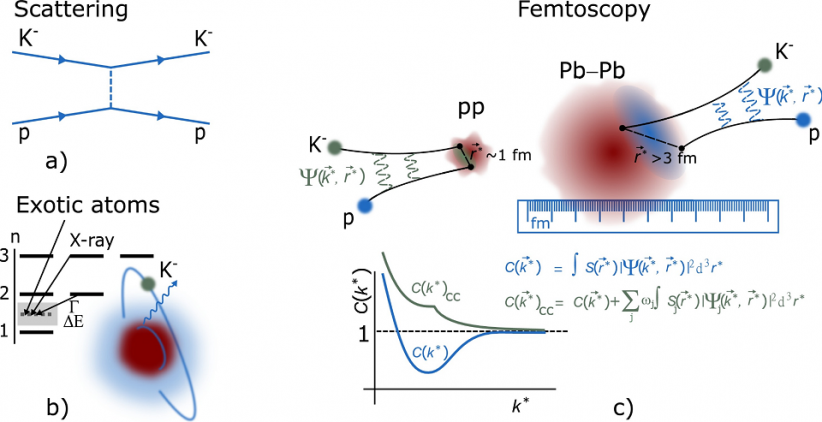ALICE experiment: progress in research
Scientists from the Faculty of Physics have published in the journal Physics Letters B the latest results of their research on changes in the characteristics of the strong interaction between ordinary matter and strange matter change.

Schematic illustration of available experimental techniques for measuring the interaction among hadrons: a) scattering experiments, b) measurements of energy shifts from the X-ray de-excitation spectrum of exotic atoms, c) femtoscopy in small collision systems (pp) with coupled channel effects shown in green, and in large collision systems (Pb–Pb) with vanishing coupled channel contributions shown in blue.
The ordinary nuclear matter is formed from up and down quarks which build the nucleons (neutrons and protons) in atomic nuclei. Other forms of matter, where for instance a strange quark is present, also exist. The interaction between nucleons and the lightest strange particles (kaons and antikaons) is a crucial element used in theoretical Quantum Chromodynamics calculations where kaons are active degrees of freedom. Due to the solid residual force, this interaction is very different within the distance ranges typical for an atomic nucleus. If at distances about the nucleon size has an attractive nature, it becomes repulsive when increasing the distance towards the nucleus size.
The exceptional capability of the ALICE detector to measure and identify particles produced in ultrarelativistic particle collisions at the LHC, together with the precise determination of the strong interaction from the analysis of two-particle momentum correlation, called femtoscopy, provide us with the necessary tools to assess the interplay between the strong and the Coulomb forces. By selecting different types of collisions, we can choose the average distance between kaons and protons. Therefore, for the first time in a single experiment, we are able to carry out a distance-dependent study of the strong interaction between antikaons and protons in the range of 10-15 - 10-14 m.
WUT scientists results confirm the change of the nature of the strong interaction from attraction to repulsion when the average distance between an antikaon and a proton is increased from 10-15 m to 4x10-15 m and further on.
In Physics Letters B a publication entitled "Kaon–strong proton interaction at low relative momentum via femtoscopy in Pb–Pb collisions at the LHC" has been recently published, which was prepared as part of the collaboration of the ALICE experiment at the LHC at CERN. The editorial committee (Paper Committee - PC) responsible for the publication consists almost entirely of employees and doctoral students from the Faculty Physics (Prof. Ph.D., D.Sc., Georgy Kornakov, Łukasz Graczykowski, Ph.D., Małgorzata Janik, Ph.D., Wioleta Rzęsa, M.Sc., Dimitar Mihaylov, Ph.D., from the Technical University of Munich, who performed some theoretical calculations used in the paper).
The research is funded within the research grant of Research Centre Priority Research High Energy Physics and Experimental Techniques under the "Excellence Initiative – Research University" project.

